You might be expecting a ‘Fowl Friday’ post, but this week we’ve decided do an ‘Owl Friday’ post instead.
In our February Garden Update we were lamenting the fact that hoards of voles (Microtus californicus) have moved into our orchard. As the orchard is fenced to keep out the deer, it also keeps most of the vole’s natural predators, like the coyotes and bobcats, from reaching them. Hence, the vole population here has recently exploded.

Owl Lunch: Vole (Microtus californicus) under the gopher guard that protects our Spitzenburg apple tree
However, not all of the vole’s predators are encumbered by fences. Especially owls.
Shortly after we moved here we demolished some rather crude and unsightly built-in-place bookshelves in the guest bedroom. Even though these shelves were aesthetically bereft, they had been constructed from solid 3/4 inch wood. For the last few years we’ve stored the wood in our workshop, and there it sat, waiting to be re-purposed as part of another project. What could be a more perfect use of recycled wood…than owl boxes!?!
Before building an owl box though, we had to know which owls to build a box for. We know from recognizing their vocalizations that we have at least three species of owl that call Curbstone Valley home. The Great Horned owl (Bubo virginianus) pictured above, Saw-Whet Owl (Aegolius acadicus), and Western Screech-Owl (Megascops kennicottii).
It’s unlikely however that we have the ubiquitous Barn Owl (Tyto alba), due to our densely forested areas, which is unfortunate, as they supposedly relish voles the most. However, the owls that do live here still enjoy a tasty rodent or three.
Great-Horned Owls don’t use nest boxes. However, both the Saw-Whet and Screech-Owls naturally nest in tree cavities, and will readily use nest boxes if they’re available.
A simple online search quickly turned up numerous Western Screech-Owl nest box plans. After reviewing a number of them, we came up with a simple design for our box.
Saw-Whet Owls, and Screech-Owls have similar needs in regards to overall nest box dimensions. We constructed this box specifically to suit our Screech-Owls, but either species may utilize it. As construction projects here go, this owl box was tremendously easy to build. In just a few short hours, with some simple straight cuts, a few wood screws, wood glue, a little silicon caulk, and some paint, a new move-in condition box was quickly put together.
Once all the pieces were cut, they were ready for assembly.
The interior of the box is 8 inches square, and 15 inches high from the top of the floor, to the top of the face. The most important consideration, other than overall dimension, was the size and location of the entrance hole. For Western Screech-Owls an entrance hole 3 inches in diameter is recommended. The distance from the top of the floor to the top of the entrance hole ideally should be 12 inches.
The entrance hole is most easily cut using a 3 inch diameter hole saw attached to a drill, however, our largest hole saw was only 2 inches, so we free-handed the cut with a jig-saw.
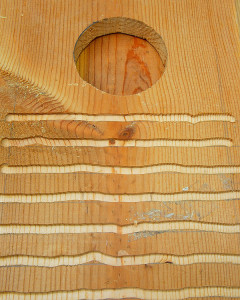
Shallow cuts were made on the interior of the front plate to improve traction for owls leaving the nest box
Shallow rungs were cut into the inside of the face board using a router. Precision is not required, and as you can see we free-handed those cuts too. The rungs are simply to help young owls gain traction when scrabbling up toward the entrance hole during feeding and fledging.
Note that the wood we were recycling was already painted on one side, so we turned the unfinished surfaces toward the interior of the box.
We used wood screws for assembly, in part because this allowed us to make a simple swivel hinge for the door. Although most owl box plans we looked at suggested hinging the roof, we favored hinging the front of the box instead. First, with the hinge on the roof, we were concerned about excess water leaching down inside the box. By fixing the roof in place we were able to seal the seam where the roof meets the backboard with a little caulk, to help make it water-tight. Second, we wanted the box to be easy to clean. It seemed much easier to us to reach in from the front of the box, than down from above.
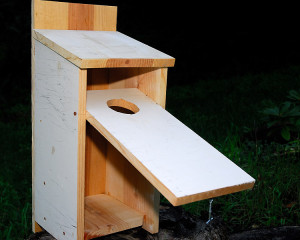
With the front plate hinged, minor debris can be cleared from the box without having to take it off the tree
In case water finds its way into the box, we nipped the corners off the bottom board, and drilled a central drainage hole.
The face board is positioned to leave a small gap just under the roof for venting.
With sufficient ventilation, and drainage, our box was almost complete. Note however that we did NOT install a perch at the entrance to the box! Whether you build or buy owl boxes, please ensure they do NOT have entrance perches. Owls don’t need them, and they merely facilitate predators gaining entry to the box to steal eggs and young.
With our new owl box fully assembled, the next task was to prime and paint the exterior surfaces. We didn’t have a choice in the wood species used for this box as we were recycling wood we already had on hand, and unpainted fir would be very short-lived here. Had we built the box from redwood, or another rot-resistant species, we could have skipped the painting step altogether.
With a little paint though, we went from hideously ugly bookshelves, to a beautiful owl box, in less than a day…
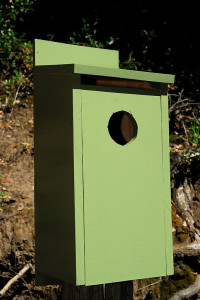
The owl box was first primed, and then painted with an exterior semi-gloss paint to resist the weather
The next morning the box was bolted to a large Douglas Fir tree approximately 20 feet above the ground, with a lovely view of the meadow and orchard (and hopefully a clear view of our vole population).
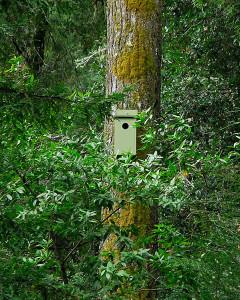
"Wanted: Vole Control Supervisor in exchange for a move-in condition studio apartment, with excellent views, in a serene woodland setting"
As we still have a lot more wood left over, and a lot more trees on the property, we’ll definitely be building more boxes. Our goal is to soon be finding a LOT more of these…

Owl castings (pellets) collected from below a Great Horned Owl nest on the farm (click to enlarge image - do you recognize any of these bones?)
We know that the owls alone won’t be able to keep the vole population below potentially damaging levels, but every vole they take, is one less we have to worry about!

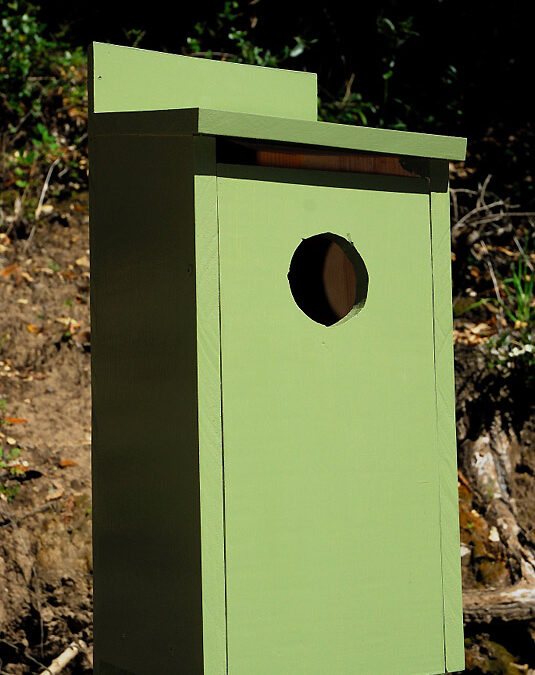
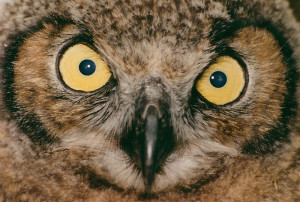


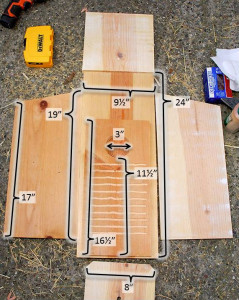
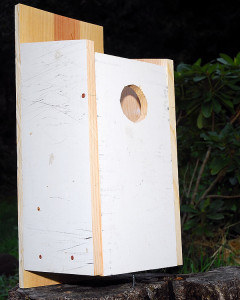
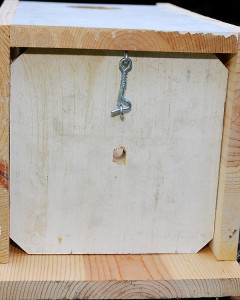
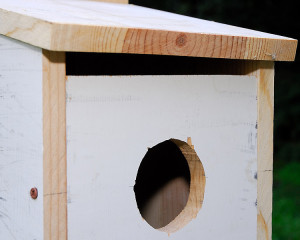







Hello Clare
I was looking at owl boxes in a retail outlet this week. We have an owl near the house and every night at the same time at this time of year I can hear him calling so loudly that I can hear it through the double glazing. I hope your new owl boxes will have residents very soon.
I wonder if your owl is like our Saw-Whet Owls. They’re essentially silent all year, except during the breeding the season. It’s amazing how loud they can be. I hope ours finds a mate soon, and moves in…before the squirrels do! 😉
love your big owl eyes
love picking through owl pellets
(makes my wife squirm)
I’d don’t find them often so maybe I should build some boxes.
Doesn’t hurt to build an owl box. I bet you have some scrap wood lying around that would work perfectly. I love picking apart owl pellets…I’m sure Mr. CV thinks that’s slightly strange. I just think it’s fun to see what the owls have been eating 😛
Now, how did you shimmy 20 feet up? I have a bat house to hang and I’ve got to see how high they need to be.
I hope you have a nice owly to make her nest there this year.
You don’t want to see how we did it 😉 Actually, we used a very tall extension ladder, but had it set on top of an old Douglas Fir stump that’s a few feet high, that just happens to be right in front of this tree. **Do NOT try this at home** That’s why we wanted to make the box easy to clean. The less trips up that ladder, the better!
Looking good! I hope you have a hungry owl in the ‘studio’ soon!
Me too! With lots of hungry little owls to feed 😉
Hope an owl finds a home there! Good use of what some might call scrap.
Our cat gets her share of vole and mice. We have Barred Owls, a few weeks ago we heard our second ever Great Horned Owl here.
An outdoor cat can make an enormous dent in the vole population. Unfortunately, our coyotes here tend to make enormous dents in the cats. They just don’t survive long out here, and I don’t have the heart to have one. Hopefully the owl box will help.
Oh, my mom has a neverending battling going with the voles… unfortunately many years she loses. I am SO glad I don’t have those things.
I would like me an owl though… 🙂 I wonder if there are any urban owls.
You’d be surprised where you see owls. I’ve seen Great Horned Owls in the city, and definitely Barn Owls too. They’re ubiquitous throughout most of the United States, except some of the northern states. I’d try putting up a Barn Owl box and see who moves in. If not for you, then at least for your poor Mom…Barn Owls LOOOOOVE voles 😉
How interesting! However, owls tend to go after our chickens. Otherwise, I really love them.
I could see the Great Horned Owls being a potential poultry threat, especially at dawn and dusk here. However, I’ve only ever seen one anywhere near the chickens in four years, and never had one try to attack one of our girls. We have so much trouble with Bobcats and Coyotes, that I don’t really consider the owls to be much of a threat by comparison here. The Cooper’s Hawks are a different story though. One caught a neighbor’s chicken recently. Predator issues though are so variable depending on where you live. I can understand not wanting to encourage owls if they have an eye for your girls 😉
Very cool! I hope this works out for you. We’ve had an owl box up for over a year, but we’re at the edge of owl habitat and so far, no one has taken the opportunity. But I keep hoping – lots of squirrels here to feed the owl babies with.
I’m half expecting the squirrels to move in instead of owls. Although, considering how loud and owly it sounds here at night, we have reasonable odds that someone might take the job and move in 😉 Crossing my fingers!
A few years back, I learned of the location of a Great Horned Owl nest in Berkeley. Oh my goodness, those babies were like gigantic evil teddy bears!
You’re right, GHOs look HUGE as youngsters when you see them in person. They do have a very teddy bear-like quality about them at the stage I photographed that one. I’m always in awe of how huge their feet are as babies…and those eyes…those enormous eyes!
Nesting boxes are always fun to build, and watch. I had wood duck boxes for many years and it was fascinating to watch them and the ducks.
Hopefully you will soon have a new tenant in your very chic apartment!
Ducks are so much fun to watch. We just have your garden variety mallards here that hang out down by the creeks in late spring. I didn’t know people built boxes for wood ducks…how fun!
I love the modifications you made to your owl house design. We followed the basic plans offered by Audubon, but we decided that next time we’d build a hinge from the side instead of the top. I like your front hinge though — even better! I know what you mean about the scary installation way up high. An extension ladder is most definitely required, as is a lot of bravery!
We considered the side door, but leaning to the side on an extension ladder makes me queasy…even if I’m not one the doing it. Then again, ladders in general make me queasy. I certainly wasn’t brave enough to climb it. Mr. CV is much braver than I am! 😛
Adore owls, Clare, and tempted to put boxes up here at the cottage (where we are this weekend) and where voles are an issue in our huge rolling lawn down to the lake. Good luck with your rentals and Happy Spring 🙂
They’re easy to build, and I’ve also seen a number online that are pre-built. I’d certainly put one up, it can’t hurt…especially if you have someone willing to climb a ladder for you ;). They more affordable than some other methods of vole control. Unless, like me, you then need the spotting scope so you can spy on the owls once they move in!
Clare, another excellent post. We have a large vole population currently being monitored by our cats but despite their diligence I discovered major damage to newly planted trees this spring. Perhaps encouraging owls to nest on our property would be more helpful (although they might be more interested in eating the cats!)
Most owls would probably be more afraid of your cats. That said though, the Great Horned Owls might have the most potential to be a problem, but I expect it’s quite unlikely unless your cats discovered a nest or a fledgling. For now, I’d wait and see what your cats can do. I wish we could have one or two here. They’d probably spend countless hours in the orchard playing whack-a-vole! 😛
Hi CV,
I hope your nest box soon has some Owly residents in them!
I wonder if there’s some way you can have an opening in the fence to allow through the predators without also allowing the Deer in too. Problem is, you won’t stop fawns getting in as they’re so small.
Unfortunately, it’s really not possible to give the predators access to the orchard without inviting the deer back in. I also think our hens that live in the orchard would be very unamused! 😉
You do amaze me. Every project you undertake is so well thought out and executed to perfection. Your owls will be nesting in owl world luxury, and with such a plentiful food source, they will be living the lifestyle of the rich and famous!
What a great post, Clare. We’ve seen signs out in our area advertising “Owl Boxes” for sale with a phone# and website. So when I checked out the website, I found out they were charging $700 for the owl boxes!! Of course the price includes installation, but it’s still an obscene amount. We’ve got plenty of scrap wood and now I have your step-by-step design to follow, so thanks very much!
Ok, seriously, I almost spit my coffee at the computer screen! $700? Why? Is that hazard pay? 😛 Sheesh! I admit, I’m not a fan of extension ladders, but we made this box for less than a Starbucks latte, and a few ounces of bravery. I agree, that’s an obscene amount of money for an owl box. For that price it better come with pre-installed owls!
Cool! What a great idea. I hope your box runneth over with owlets, and that we may all enjoy them (virtually) along with you.
Your first owl photo is really quite intimidating! Here’s hoping the local vole population agrees and heads for the hills… Lovely clear instructions, if I ever get to live somewhere with a suitable site for such a thing I would love to build one.
I love owls. We have great horned, barred, and barn owls around here. Building a nesting box for them would be a great project for my free time, ha-ha.
brilliant!
Another interesting post. You two just never run out of great ideas. I love how the owl boxes turned out. I hope they start controlling the voles for you. My oldest daughter said they’ve been dissecting owl pellets in science and guess what skulls they found in it… voles! 🙂
I love dissecting pellets. It’s a great way to learn skeletal anatomy. We’re hoping to find a few extra vole skulls in pellets here soon too! 😉
I really enjoyed your owl habitat boxes post. I hope you are successful at curtailing your vole population. It will be fun seeing your houses get their first residents too.
What a great set of pictures illustrating your box-building process! I will have to bookmark this post and maybe make one of my own! We have the same species (although likely different subspecies), and a few more. I love owls! (and hate voles & gophers too!)
That’s it Clare, I’ve decided that there is absolutely nothing that you can’t do!
We’ve Boobooks and Tawny Frogmouths in the bushland not far from where we live. I am amazed by your photo of the Great Horned Owl – how did you get such a wonderful close up shot?
Heidi, I cheated. The juvenile Great Horned Owl in the first photo was from about 15 years ago. It was an owl that had fallen from a tree and was being cared for at a rescue facility I used to work at. Mr. CV was holding him during a late night feeding. I’m sure the look of disdain on the owl’s face was because he was wondering where dinner was 😉
Cheating is allowed if you are nursing a creature back to good health! Still a great shot!
Clare, you are so talented. That is a very professional crafted nest box. I love the color . . . hope the paint fumes will fade away quickly and I look forward to seeing your photos of an owl flying to and fro. I hope they have a large brood and feast on those voles. Nothing I dislike more than voles and rabbits. They both do so much damage to our efforts at farming and gardening. Hawks are great predators here. Still there are so many voles to deal with.